Effectiveness of Natural Products—Artemisia dubia and Manure Digestate—On Winter Wheat Cultivation
Abstract
1. Introduction
2. Results
2.1. Effect of Pig Manure Digestate and Artemisia dubia on Soil Chemical Composition
2.2. Influence on Crop Overwintering
2.3. Impact on Weeds and Winter Wheat Disease
2.4. Impact on Winter Wheat Disease
3. Discussion
3.1. Soil Change After Two Years of Experiment
3.2. Effects of Applied Natural Materials on Weeds and Crop Diseases
4. Materials and Methods
4.1. Experimental Site Description and Weather
4.2. Experimental Design
4.3. Determination of Soil Chemical Composition
4.4. Assessment of Weediness and Diseases
4.5. Statistics
5. Conclusions
- -
- Pig manure digestate affected the soil more effectively when used alone compared to the treatments in which it was combined with synthetic fertilizers or crushed Artemisia dubia biomass.
- -
- The highest amount of total N in the soil was accumulated when crushed Artemisia dubia biomass was incorporated and combined fertilization (organic and synthetic fertilizers together) was applied.
- -
- In treatments with incorporated Artemisia dubia biomass, a significant decrease in the prevalence of weeds was observed. This suggests that Artemisia dubia biomass can be used as a natural weed control tool as well as contribute to reducing the intensity of pathogens.
Author Contributions
Funding
Data Availability Statement
Conflicts of Interest
References
- Kirchmann, H. Revisiting the Original Reasons for Excluding Inorganic Fertilizers in Organic Farming—Why the Ban Is Not Consistent with Our Current Scientific Understanding. Outlook Agric. 2021, 50, 107–115. [Google Scholar] [CrossRef]
- Jacques, A.; Laurent, M.; Ribière-Chabert, M.; Saussac, M.; Bougeard, S.; Budge, G.E.; Hendrikx, P.; Chauzat, M.P.; De Graaf, D.; Estelle, M.; et al. A Pan-European Epidemiological Study Reveals Honey Bee Colony Survival Depends on Beekeeper Education and Disease Control. PLoS ONE 2017, 12, e0172591. [Google Scholar] [CrossRef] [PubMed]
- Goulson, D. Pesticides, Corporate Irresponsibility, and the Fate of Our Planet. One Earth 2020, 2, 302–305. [Google Scholar] [CrossRef]
- Tripathi, S.; Srivastava, P.; Devi, R.S.; Bhadouria, R. Influence of Synthetic Fertilizers and Pesticides on Soil Health and Soil Microbiology. In Agrochemicals Detection, Treatment and Remediation: Pesticides and Chemical Fertilizers; Elsevier: Amsterdam, The Netherlands, 2020; pp. 25–54. ISBN 9780081030172. [Google Scholar]
- Bhandari, G. An Overview of Agrochemicals and Their Effects on Environment in Nepal. Appl. Ecol. Environ. Sci. 2014, 2, 66–73. [Google Scholar] [CrossRef]
- Baweja, P.; Kumar, S.; Kumar, G. Fertilizers and Pesticides: Their Impact on Soil Health and Environment. In Soil Health; Springer: Cham, Swizterland, 2020; pp. 265–285. [Google Scholar] [CrossRef]
- Litvinova, O.; Tonkha, O.; Havryliuk, O.; Litvinov, D.; Symochko, L.; Dehodiuk, S.; Zhyla, R. Fertilizers and Pesticides Impact on Surface-Active Substances Accumulation in the Dark Gray Podzolic Soils. J. Ecol. Eng. 2023, 24, 119–127. [Google Scholar] [CrossRef] [PubMed]
- Zhang, N.; Pan, R.; Shen, Y.; Yuan, J.; Wang, L.; Luo, X.; Raza, W.; Ling, N.; Huang, Q.; Shen, Q. Development of a Novel Bio-Organic Fertilizer for Plant Growth Promotion and Suppression of Rhizome Rot in Ginger. Biol. Control 2017, 114, 97–105. [Google Scholar] [CrossRef]
- Wang, Y.; Zhu, Y.; Zhang, S.; Wang, Y. What Could Promote Farmers to Replace Chemical Fertilizers with Organic Fertilizers? J. Clean. Prod. 2018, 199, 882–890. [Google Scholar] [CrossRef]
- Elalami, D.; Monlau, F.; Carrere, H.; Abdelouahdi, K.; Oukarroum, A.; Zeroual, Y.; Barakat, A. Effect of Coupling Alkaline Pretreatment and Sewage Sludge Co-Digestion on Methane Production and Fertilizer Potential of Digestate. Sci. Total Environ. 2020, 743, 140670. [Google Scholar] [CrossRef]
- Verdi, L.; Kuikman, P.J.; Orlandini, S.; Mancini, M.; Napoli, M.; Dalla Marta, A. Does the Use of Digestate to Replace Mineral Fertilizers Have Less Emissions of N2O and NH3 ? Agric. For. Meteorol. 2019, 269–270, 112–118. [Google Scholar] [CrossRef]
- Greenberg, I.; Kaiser, M.; Gunina, A.; Ledesma, P.; Polifka, S.; Wiedner, K.; Mueller, C.W.; Glaser, B.; Ludwig, B. Substitution of Mineral Fertilizers with Biogas Digestate plus Biochar Increases Physically Stabilized Soil Carbon but Not Crop Biomass in a Field Trial. Sci. Total Environ. 2019, 680, 181–189. [Google Scholar] [CrossRef]
- Koszel, M.; Lorencowicz, E. Agricultural Use of Biogas Digestate as a Replacement Fertilizers. Agric. Agric. Sci. Procedia 2015, 7, 119–124. [Google Scholar] [CrossRef]
- Stolarski, M.J.; Krzyżaniak, M.; Warmiński, K.; Tworkowski, J.; Szczukowski, S.; Olba-Zięty, E.; Gołaszewski, J. Energy Efficiency of Perennial Herbaceous Crops Production Depending on the Type of Digestate and Mineral Fertilizers. Energy 2017, 134, 50–60. [Google Scholar] [CrossRef]
- Baksinskaite, A.; Doyeni, M.O.; Tilvikiene, V. Influence of Artemisia Dubia Wall and Pig Manual Digestate on Winter Wheat Productivity and Grain Quality. Agriculture 2024, 14, 1819. [Google Scholar] [CrossRef]
- Li, H.; Feng, W.-T.; He, X.-H.; Zhu, P.; Gao, H.-J.; Sun, N.; Xu, M.-G. Chemical Fertilizers Could Be Completely Replaced by Manure to Maintain High Maize Yield and Soil Organic Carbon (SOC) When SOC Reaches a Threshold in the Northeast China Plain. J. Integr. Agric. 2017, 16, 937–946. [Google Scholar] [CrossRef]
- Pincus, L.; Margenot, A.; Six, J.; Scow, K. On-Farm Trial Assessing Combined Organic and Mineral Fertilizer Amendments on Vegetable Yields in Central Uganda. Agric. Ecosyst. Environ. 2016, 225, 62–71. [Google Scholar] [CrossRef]
- Römer, U.; Schaak, H.; Mußhoff, O. The Perception of Crop Protection: Explicit vs. Implicit Association of the Public and in Agriculture. J. Environ. Psychol. 2019, 66, 101346. [Google Scholar] [CrossRef]
- Arias-Estévez, M.; López-Periago, E.; Martínez-Carballo, E.; Simal-Gándara, J.; Mejuto, J.C.; García-Río, L. The Mobility and Degradation of Pesticides in Soils and the Pollution of Groundwater Resources. Agric. Ecosyst. Environ. 2008, 123, 247–260. [Google Scholar] [CrossRef]
- Ayilara, M.S.; Adeleke, B.S.; Akinola, S.A.; Fayose, C.A.; Adeyemi, U.T.; Gbadegesin, L.A.; Omole, R.K.; Johnson, R.M.; Uthman, Q.O.; Babalola, O.O. Biopesticides as a Promising Alternative to Synthetic Pesticides: A Case for Microbial Pesticides, Phytopesticides, and Nanobiopesticides. Front. Microbiol. 2023, 14, 1040901. [Google Scholar] [CrossRef]
- Abdollahdokht, D.; Gao, Y.; Faramarz, S.; Poustforoosh, A.; Abbasi, M.; Asadikaram, G.; Nematollahi, M.H. Conventional Agrochemicals towards Nano-Biopesticides: An Overview on Recent Advances. Chem. Biol. Technol. Agric. 2022, 9, 13. [Google Scholar] [CrossRef]
- Soyel, S.A.; Ruidas, S.; Roy, P.; Mondal, S.; Bhattacharyya, S.; Hazra, D. Biopesticides as Eco-Friendly Substitutes to Synthetic Pesticides: An Insight of Present Status and Future Prospects with Improved Bio-Effectiveness, Self-Lives, and Climate Resilience. Int. J. Environ. Sustain. Prot. 2022, 2, 1–12. [Google Scholar] [CrossRef]
- Barjees Baig, M.; Al-Zaidi, A.A.; Elhag, E.A.; Al-Otaibi, S.H.; Baig, M.B. Negative Effects of Pesticides on the Environment and the Farmers Awareness in Saudi Arabia: A Case Study. J. Anim. Plant Sci. 2011, 21, 605–611. [Google Scholar]
- Lengai, G.M.W.; Muthomi, J.W.; Mbega, E.R. Phytochemical Activity and Role of Botanical Pesticides in Pest Management for Sustainable Agricultural Crop Production. Sci. Afr. 2020, 7, e00239. [Google Scholar] [CrossRef]
- Wanzala, W.; Wagacha, M.; Dossaji, S.F.; Gakuubi, M.M.; Wagacha, J.M. Bioactive Properties of Tagetes minuta L. (Asteraceae) Essential Oils: A Review. Am. J. Essent. Oils Nat. Prod. 2016, 4, 27–36. [Google Scholar]
- Anwar, S.; Naseem, S.; Karimi, S.; Asi, M.R.; Akrem, A.; Ali, Z. Bioherbicidal Activity and Metabolic Profiling of Potent Allelopathic Plant Fractions Against Major Weeds of Wheat—Way Forward to Lower the Risk of Synthetic Herbicides. Front. Plant Sci. 2021, 12, 632390. [Google Scholar] [CrossRef]
- Wang, C.M.; Chen, H.T.; Li, T.C.; Weng, J.H.; Jhan, Y.L.; Lin, S.X.; Chou, C.H. The Role of Pentacyclic Triterpenoids in the Allelopathic Effects of Alstonia Scholaris. J. Chem. Ecol. 2014, 40, 90–98. [Google Scholar] [CrossRef] [PubMed]
- Li, Z.H.; Wang, Q.; Ruan, X.; de Pan, C.; Jiang, D.A. Phenolics and Plant Allelopathy. Molecules 2010, 15, 8933–8952. [Google Scholar] [CrossRef] [PubMed]
- Golisz, A.; Sugano, M.; Hiradate, S.; Fujii, Y. Microarray Analysis of Arabidopsis Plants in Response to Allelochemical L-DOPA. Planta 2011, 233, 231–240. [Google Scholar] [CrossRef]
- Pouresmaeil, M.; Nojadeh, M.S.; Movafeghi, A.; Maggi, F. Exploring the Bio-Control Efficacy of Artemisia Fragrans Essential Oil on the Perennial Weed Convolvulus Arvensis: Inhibitory Effects on the Photosynthetic Machinery and Induction of Oxidative Stress. Ind. Crops Prod. 2020, 155, 112785. [Google Scholar] [CrossRef]
- Liang, J.Y.; Guo, S.S.; Zhang, W.J.; Geng, Z.F.; Deng, Z.W.; Du, S.S.; Zhang, J. Fumigant and Repellent Activities of Essential Oil Extracted from Artemisia Dubia and Its Main Compounds against Two Stored Product Pests. Nat. Prod. Res. 2018, 32, 1234–1238. [Google Scholar] [CrossRef]
- Negri, S.; Pietrolucci, F.; Andreatta, S.; Chinyere Njoku, R.; Antunes Silva Nogueira Ramos, C.; Crimi, M.; Commisso, M.; Guzzo, F.; Avesani, L. Bioprospecting of Artemisia Genus: From Artemisinin to Other Potentially Bioactive Compounds. Sci. Rep. 2024, 14, 4791. [Google Scholar] [CrossRef]
- Abraham, A.; Park, H.; Choi, O.; Sang, B.-I. Anaerobic Co-Digestion of Bioplastics as a Sustainable Mode of Waste Management with Improved Energy Production—A Review. Bioresour. Technol. 2021, 322, 124537. [Google Scholar] [CrossRef] [PubMed]
- Panuccio, M.R.; Romeo, F.; Mallamaci, C.; Muscolo, A. Digestate Application on Two Different Soils: Agricultural Benefit and Risk. Waste Biomass Valorization 2021, 12, 4341–4353. [Google Scholar] [CrossRef]
- Rolka, E.; Wyszkowski, M.; Żołnowski, A.C.; Skorwider-Namiotko, A.; Szostek, R.; Wyżlic, K.; Borowski, M. Digestate from an Agricultural Biogas Plant as a Factor Shaping Soil Properties. Agronomy 2024, 14, 1528. [Google Scholar] [CrossRef]
- Bakšinskaitė, A.; Tilvikiene, V.; Barčauskaitė, K.; Feizienė, D. Potential of Artemisia Dubia Wall Biomass for Natural Crop Protection. Plants 2023, 12, 3750. [Google Scholar] [CrossRef]
- Slepetiene, A.; Volungevicius, J.; Jurgutis, L.; Liaudanskiene, I.; Amaleviciute-Volunge, K.; Slepetys, J.; Ceseviciene, J. The Potential of Digestate as a Biofertilizer in Eroded Soils of Lithuania. Waste Manag. 2020, 102, 441–451. [Google Scholar] [CrossRef]
- Doyeni, M.O.; Baksinskaite, A.; Suproniene, S.; Tilvikiene, V. Effect of Animal Waste Based Digestate Fertilization on Soil Microbial Activities, Greenhouse Gas Emissions and Spring Wheat Productivity in Loam and Sandy Loam Soil. Agronomy 2021, 11, 1281. [Google Scholar] [CrossRef]
- Sun, K.; Jiang, L.; Ye, Q.; Wang, Q.; Liao, D.; Chang, X.; Xi, S.; He, R. Chemical and Microbiological Characterization of Pig Manures and Digestates. Environ. Technol. 2023, 44, 1916–1925. [Google Scholar] [CrossRef]
- Doyeni, M.O.; Stulpinaite, U.; Baksinskaite, A.; Suproniene, S.; Tilvikiene, V. Greenhouse Gas Emissions in Agricultural Cultivated Soils Using Animal Waste-Based Digestates for Crop Fertilization. J. Agric. Sci. 2021, 159, 23–30. [Google Scholar] [CrossRef]
- Barłóg, P.; Hlisnikovský, L.; Kunzová, E. Effect of Digestate on Soil Organic Carbon and Plant-Available Nutrient Content Compared to Cattle Slurry and Mineral Fertilization. Agronomy 2020, 10, 379. [Google Scholar] [CrossRef]
- Bachmann, S.; Gropp, M.; Eichler-Löbermann, B. Phosphorus Availability and Soil Microbial Activity in a 3 Year Field Experiment Amended with Digested Dairy Slurry. Biomass Bioenergy 2014, 70, 429–439. [Google Scholar] [CrossRef]
- García-López, A.M.; Delgado, A.; Anjos, O.; Horta, C. Digestate Not Only Affects Nutrient Availability but Also Soil Quality Indicators. Agronomy 2023, 13, 1308. [Google Scholar] [CrossRef]
- Baksinskaite, A.; Toleikiene, M.; Bariseviciute, R.; Skipityte, R.; Tilvikiene, V. Mineralized Nitrogen Uptake by Plants of the Use of Synthetic Nitrogen Fertilization in Agriculture. Environ. Sustain. Indic. 2024, 23, 100423. [Google Scholar] [CrossRef]
- Cattin, M.; Semple, K.T.; Stutter, M.; Romano, G.; Lag-Brotons, A.J.; Parry, C.; Surridge, B.W.J. Changes in Microbial Utilization and Fate of Soil Carbon Following the Addition of Different Fractions of Anaerobic Digestate to Soils. Eur. J. Soil. Sci. 2021, 72, 2398–2413. [Google Scholar] [CrossRef]
- Pupalienė, R.; Jodaugienė, D.; Sinkevičienė, A.; Bajorienė, K. Organinių Mulčių Įtaka Dirvos Užterštumui Piktžolių Sėklomis. Žemės ūkio Mokslai 2012, 19. [Google Scholar] [CrossRef]
- Broschat, T.K. Effects of Mulch Type and Fertilizer Placement on Weed Growth and Soil PH and Nutrient Content. Horttechnology 2007, 17, 174–177. [Google Scholar] [CrossRef]
- Saha, D.; Marble, S.C.; Pearson, B.J. Allelopathic Effects of Common Landscape and Nursery Mulch Materials on Weed Control. Front. Plant Sci. 2018, 9, 733. [Google Scholar] [CrossRef]
- Petrikovszki, R.; Zalai, M.; Bogdányi, F.T.; Tóth, F. The Effect of Organic Mulching and Irrigation on the Weed Species Composition and the Soil Weed Seed Bank of Tomato. Plants 2020, 9, 66. [Google Scholar] [CrossRef]
- Das Mallik, B.B.; Acharya, B.; Saquib, M.; Chettri, M. Allelopathic Effect of Artemisia Dubia Extracts on Seed Germination and Seedling Growth of Some Weeds and Winter Crops. Ecoprint Int. J. Ecol. 2015, 21, 23–30. [Google Scholar] [CrossRef]
- Jamiołkowska, A. Natural Compounds as Elicitors of Plant Resistance Against Diseases and New Biocontrol Strategies. Agronomy 2020, 10, 173. [Google Scholar] [CrossRef]
- Ramanauskienė, J.; Dabkevičius, Z.; Tamošiūnas, K.; Petraitienė, E. The Incidence and Severity of Take-All in Winter Wheat and Gaeumannomyces Graminis Soil Inoculum Levels in Lithuania. Zemdirb.-Agric. 2019, 106, 37–44. [Google Scholar] [CrossRef]
- Almogdad, M.; Lukošiūtė-Stasiukonienė, A.; Semaškienė, R.; Mačiulytė, V. Sowing Date and Seed Rate Influence on Septoria Leaf Blotch Occurrence in Winter Wheat. Agriculture 2024, 14, 988. [Google Scholar] [CrossRef]
- Kone, N.; Asare-Bediako, E.; Silue, S.; Kone, D.; Koita, O.; Menzel, W.; Winter, S. Influence of Planting Date on Incidence and Severity of Viral Disease on Cucurbits under Field Condition. Ann. Agric. Sci. 2017, 62, 99–104. [Google Scholar] [CrossRef]
- ISO 10694:1995; Soil Quality—Determination of Organic and Total Carbon After Dry Combustion (Elementary Analysis). International Organization for Standardization: Geneva, Switzerland, 1995.
- ISO 10390:2005; Soil Quality—Determination of pH. International Organization for Standardization: Geneva, Switzerland, 1995.
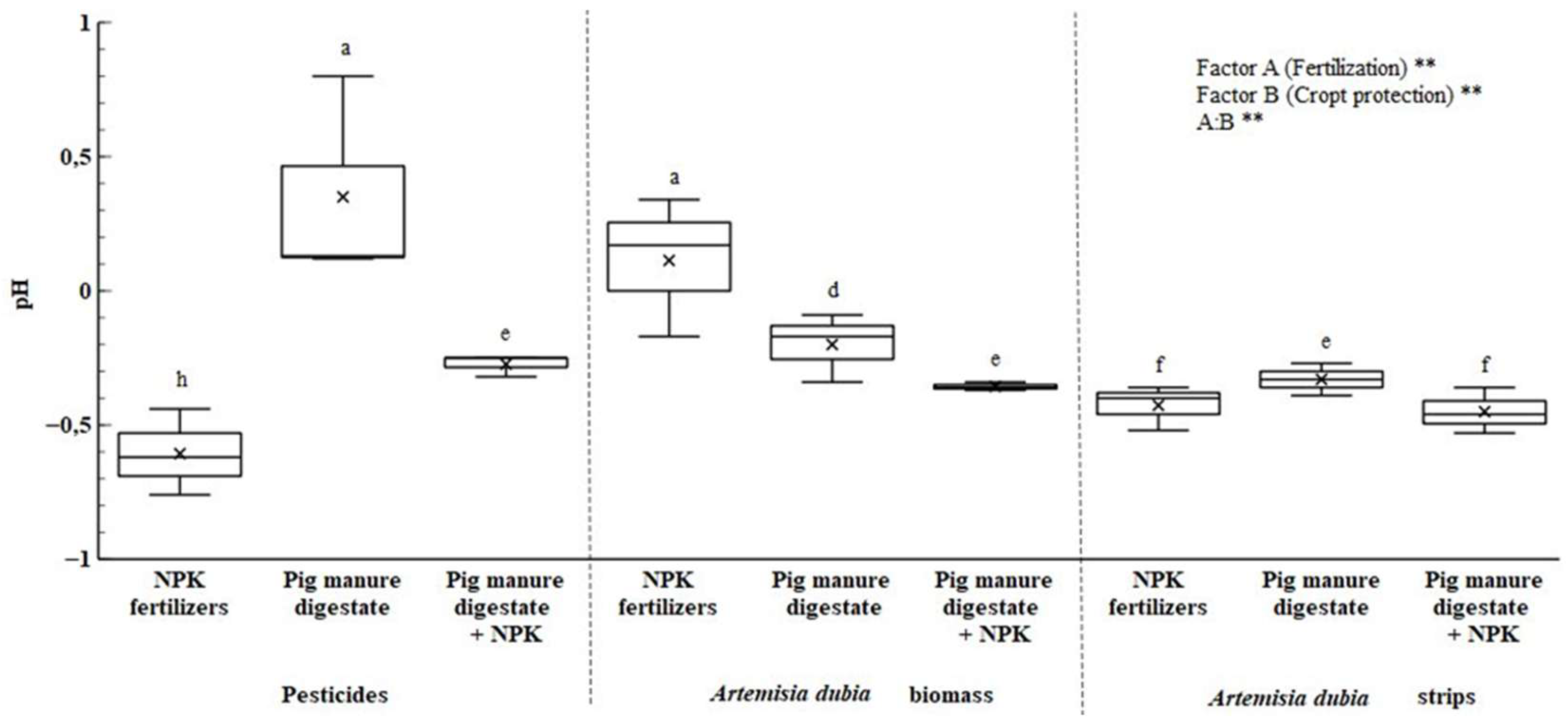
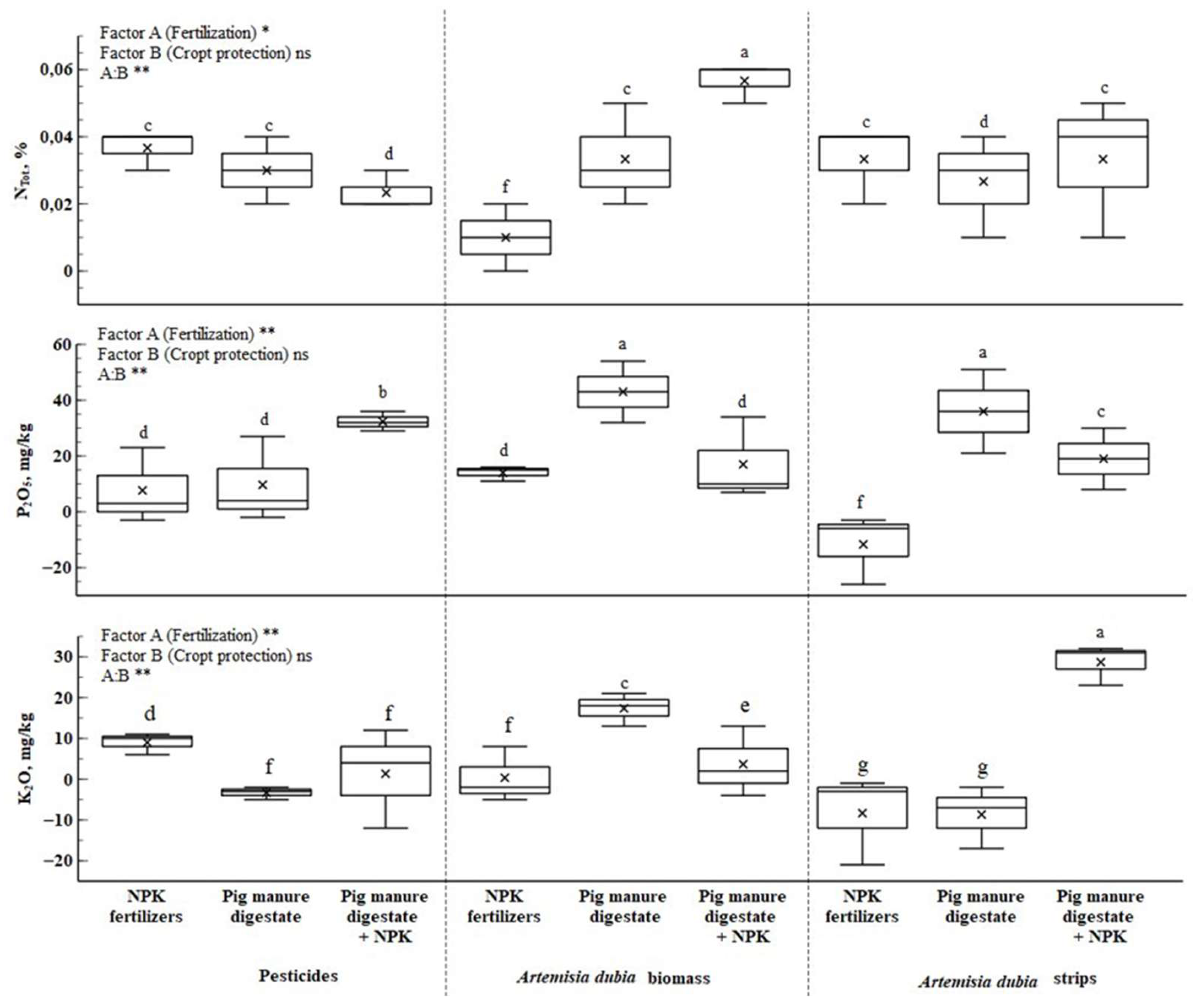
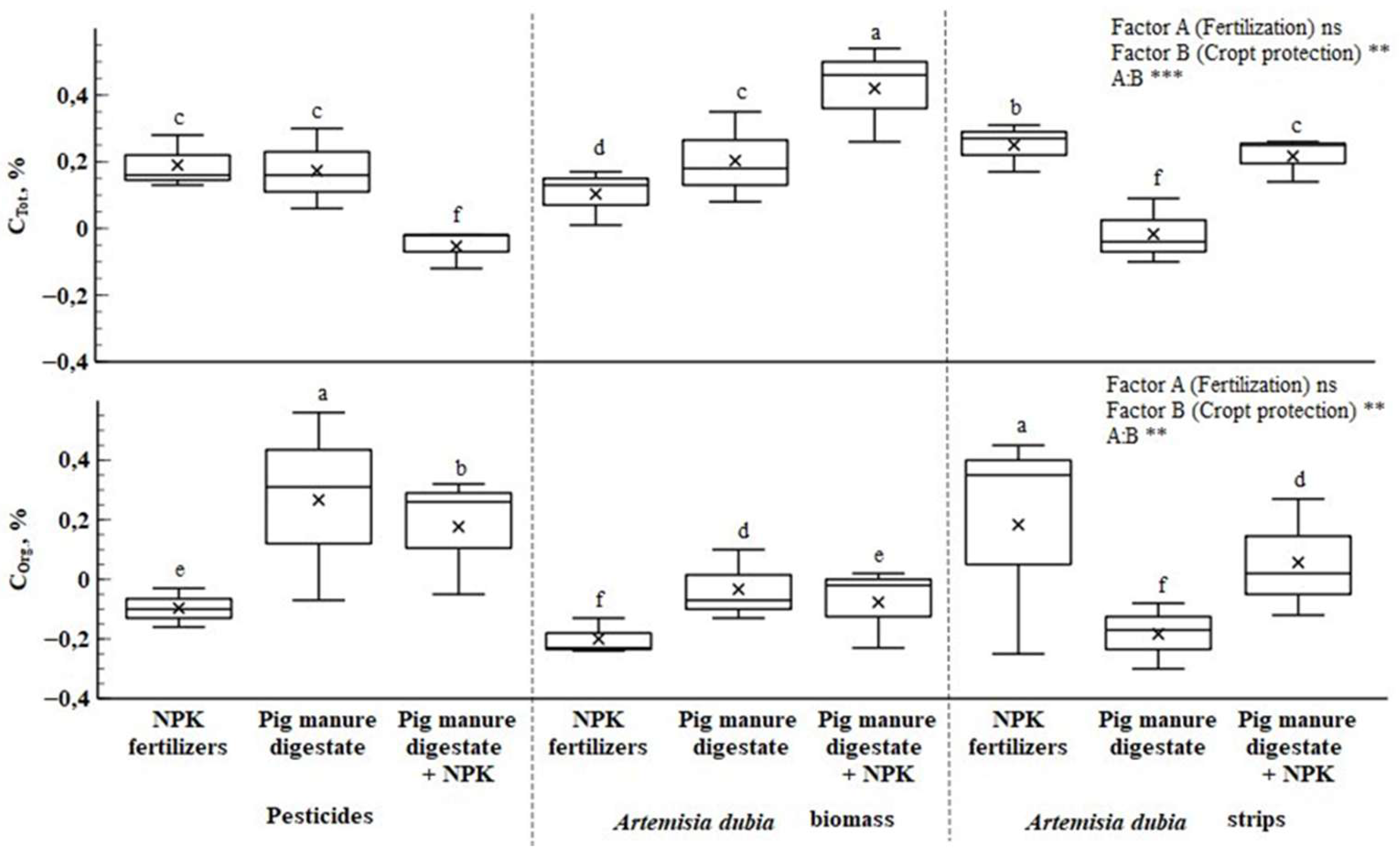

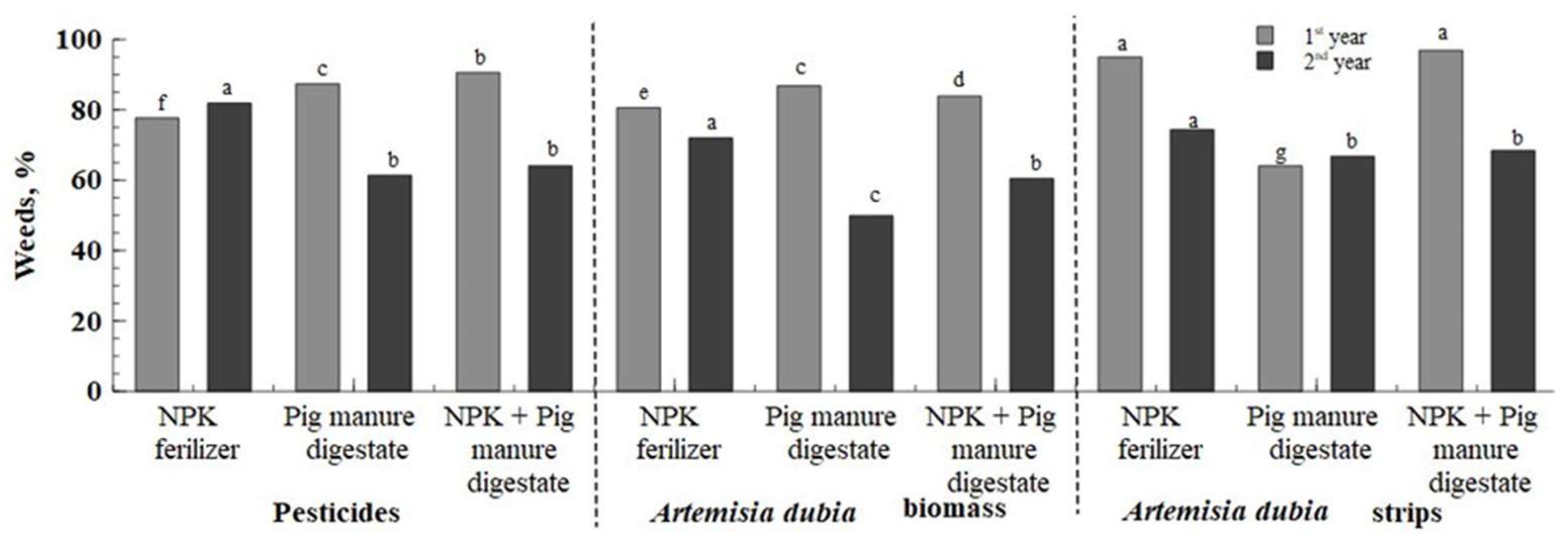
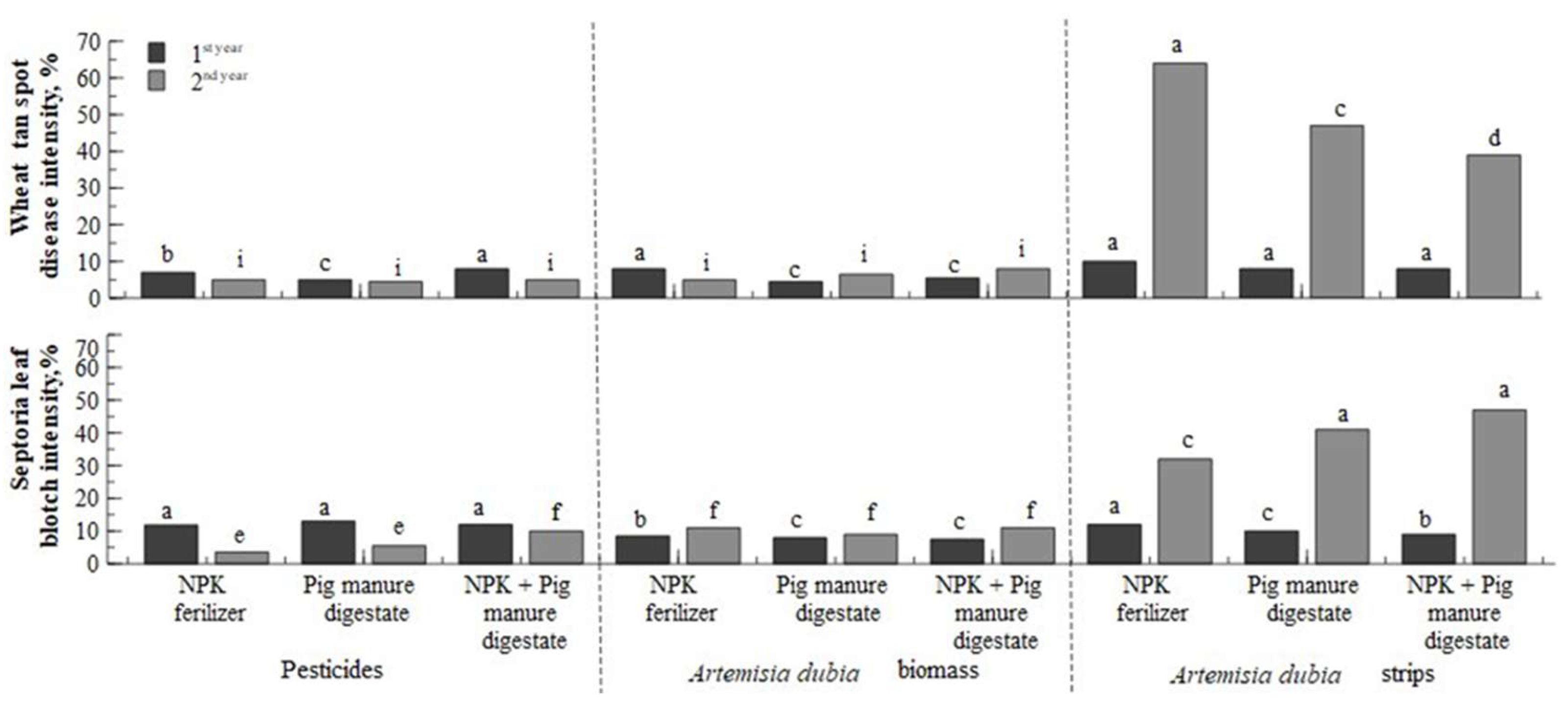
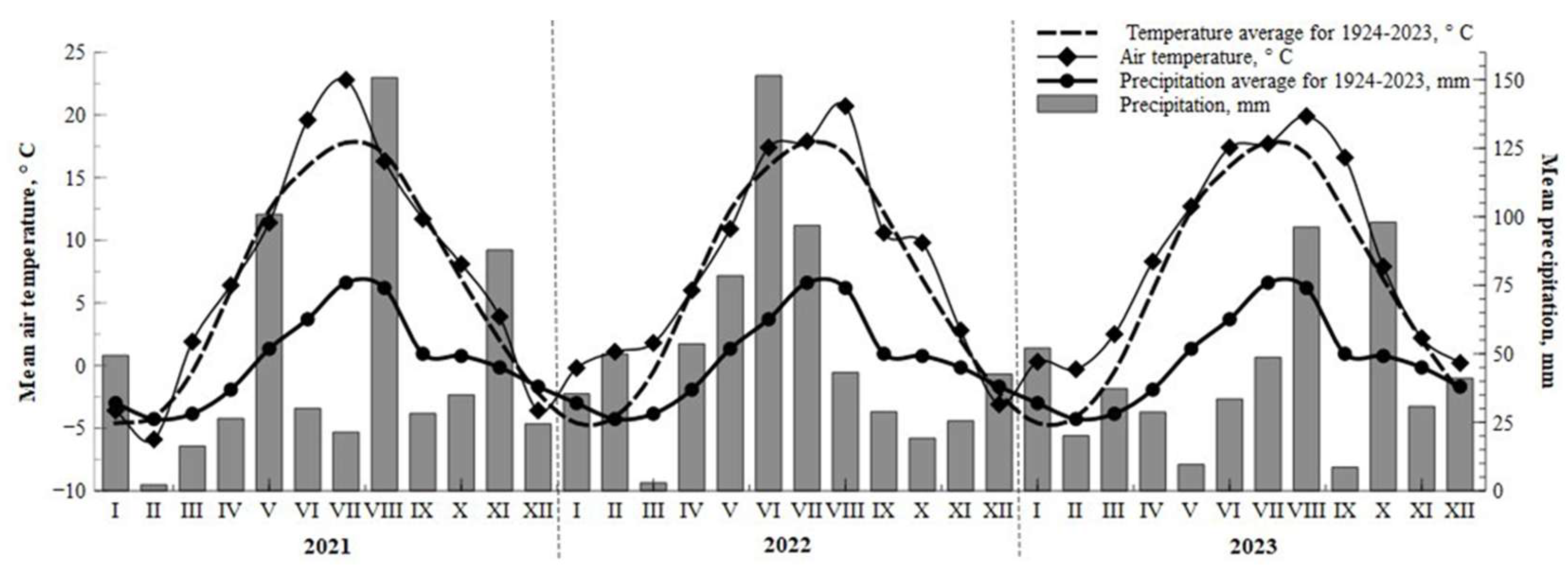
| pH | P2O5 mg/kg | K2O mg/kg | Corganic % | Ctotal % | Ntotal % |
|---|---|---|---|---|---|
| 6.52 ± 0.12 | 102.00 ± 9.12 | 118.00 ± 10.23 | 1.08 ± 0.12 | 1.39 ± 0.30 | 0.14 ± 0.01 |
| Factor A (Fertilization) | Factor B (Crop Protection) |
|---|---|
| Synthetic (NPK) fertilizers | Pesticides |
| Pig manure digestate | Artemisia dubia biomass |
| Pig manure digestate combination with synthetic (NPK) fertilizers | Artemisia dubia strips |
| 2022 | 2023 | |||
|---|---|---|---|---|
| 1st Fertilization | 2nd Fertilization | 1st Fertilization | 2nd Fertilization | |
| Ntotal, % | 0.240 | 0.315 | 0.216 | 0.272 |
| P2O5, % | 0.012 | 0.016 | 0.033 | 0.062 |
| K2O, % | 0.146 | 0.121 | 0.142 | 0.084 |
| pH | 8.23 | 8.40 | 8.51 | 8.60 |
Disclaimer/Publisher’s Note: The statements, opinions and data contained in all publications are solely those of the individual author(s) and contributor(s) and not of MDPI and/or the editor(s). MDPI and/or the editor(s) disclaim responsibility for any injury to people or property resulting from any ideas, methods, instructions or products referred to in the content. |
© 2025 by the authors. Licensee MDPI, Basel, Switzerland. This article is an open access article distributed under the terms and conditions of the Creative Commons Attribution (CC BY) license (https://creativecommons.org/licenses/by/4.0/).
Share and Cite
Baksinskaite, A.; Doyeni, M.O.; Ramanauskienė, J.; Feizienė, D.; Tilvikiene, V. Effectiveness of Natural Products—Artemisia dubia and Manure Digestate—On Winter Wheat Cultivation. Plants 2025, 14, 1411. https://doi.org/10.3390/plants14101411
Baksinskaite A, Doyeni MO, Ramanauskienė J, Feizienė D, Tilvikiene V. Effectiveness of Natural Products—Artemisia dubia and Manure Digestate—On Winter Wheat Cultivation. Plants. 2025; 14(10):1411. https://doi.org/10.3390/plants14101411
Chicago/Turabian StyleBaksinskaite, Ausra, Modupe Olufemi Doyeni, Jurate Ramanauskienė, Dalia Feizienė, and Vita Tilvikiene. 2025. "Effectiveness of Natural Products—Artemisia dubia and Manure Digestate—On Winter Wheat Cultivation" Plants 14, no. 10: 1411. https://doi.org/10.3390/plants14101411
APA StyleBaksinskaite, A., Doyeni, M. O., Ramanauskienė, J., Feizienė, D., & Tilvikiene, V. (2025). Effectiveness of Natural Products—Artemisia dubia and Manure Digestate—On Winter Wheat Cultivation. Plants, 14(10), 1411. https://doi.org/10.3390/plants14101411







